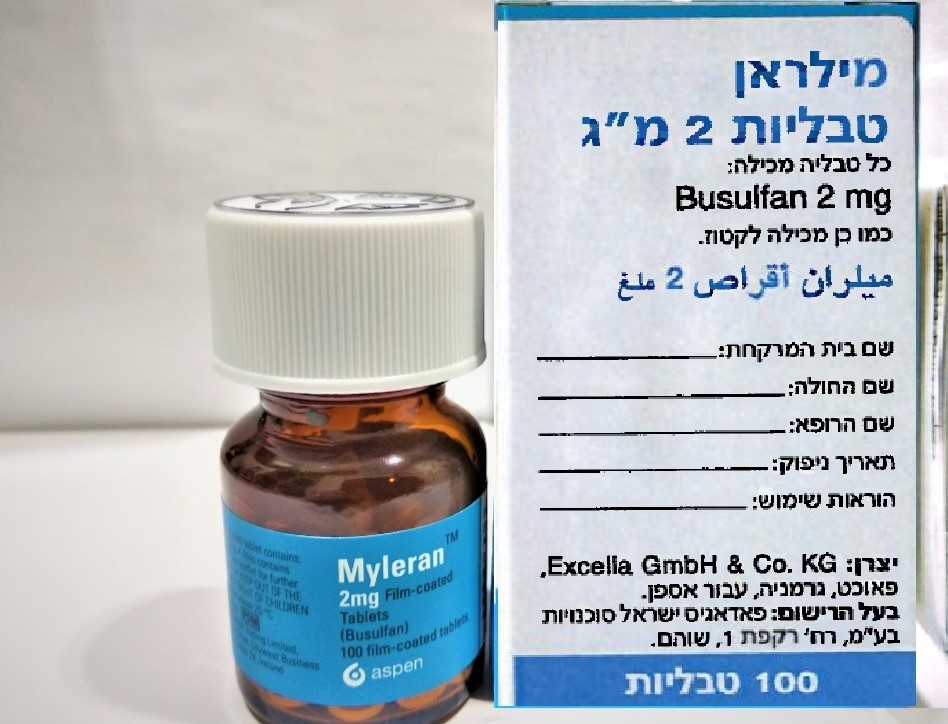Quest for the right Drug

מילראן טבליות 2 מ"ג MYLERAN TABLETS 2 MG (BUSULFAN)
תרופה במרשם
תרופה בסל
נרקוטיקה
ציטוטוקסיקה
צורת מתן:
פומי : PER OS
צורת מינון:
טבליה : TABLETS
עלון לרופא
מינוניםPosology התוויות
Indications תופעות לוואי
Adverse reactions התוויות נגד
Contraindications אינטראקציות
Interactions מינון יתר
Overdose הריון/הנקה
Pregnancy & Lactation אוכלוסיות מיוחדות
Special populations תכונות פרמקולוגיות
Pharmacological properties מידע רוקחי
Pharmaceutical particulars אזהרת שימוש
Special Warning עלון לרופא
Physicians Leaflet
Pharmacological properties : תכונות פרמקולוגיות
Pharmacodynamic Properties
5.1 Pharmacodynamic properties Group and ATC code: Antineoplastic and Immunomodulating agents, alkyl sulfonates: LO1 ABO1. Busulfan (1,4-butanediol dimethanesulfonate) is a bifunctional alkylating agent. Binding to DNA is believed to play a role in its mode of action and di-guanyl derivatives have been isolated but interstrand crosslinking has not been conclusively demonstrated. The basis for the uniquely selective effect of busulfan on granulocytopoiesis is not fully understood. Although not curative, Busulfan is very effective in reducing the total granulocyte mass, relieving the symptoms of disease and improving the clinical state of the patient. Busulfan has been shown to be superior to splenic irradiation when judged by survival times and maintenance of haemoglobin levels and is as effective in controlling spleen size.
Pharmacokinetic Properties
5.2 Pharmacokinetic properties Absorption The bioavailability of oral Busulfan shows large intra-individual variations ranging from 47 % to 103 % (mean 80 %) in adults. The area under the curve (AUC) and peak plasma concentrations (Cmax) of Busulfan have been shown to be linearly dose dependent. Following administration of a single 2 mg oral dose of Busulfan, the AUC and Cmax of Busulfan were 125 ± 17 nanograms.h/ml and 28 ± 5 nanograms/ml respectively. A lag time between Busulfan administration and detection in the plasma of up to 2 h has been reported. High-dose Treatment Drug was assayed either using gas liquid chromatography with electron capture detection or by high-performance liquid chromatography (HPLC). Following oral administration of high- dose Myleran (1 mg/kg every 6 h for 4 days), AUC and Cmax in adults are highly variable but have been reported to be 8260 nanograms.h/ml (range 2484 to 21090) and 1047 nanograms/ml (range 295 to 2558) respectively when measured by HPLC and 6135 nanograms.h/ml (range 3978 to 12304) and 1980 nanograms/ml (range 894 to 3800) respectively using gas chromatography. Distribution Busulfan is reported to have a volume of distribution of 0.64 ± 0.12 L/kg in adults. Busulfan given in high-doses has recently been shown to enter the cerebrospinal fluid (CSF) in concentrations comparable to those found in plasma, with a mean CSF:plasma ratio of 1.3:1. The saliva:plasma distribution of Busulfan was 1.1:1. The level of busulfan bound reversibly to plasma proteins has been variably reported to be insignificant or approximately 55 %. Irreversible binding of drug to blood cells and plasma proteins has been reported to be 47 % and 32 %, respectively. Biotransformation Busulfan metabolism involves a reaction with glutathione, which occurs via the liver and is mediated by glutathione-S-transferase. The urinary metabolites of busulfan have been identified as 3-hydroxysulpholane, tetrahydrothiophene 1-oxide and sulpholane, in patients treated with high-dose Busulfan. Very little busulfan is excreted unchanged in the urine. Elimination Busulfan has a mean elimination half life of between 2.3 and 2.8 h. Adult patients have demonstrated a clearance of busulfan of 2.4 to 2.6 ml/min/kg. The elimination half life of busulfan has been reported to decrease upon repeat dosing suggesting that busulfan potentially increases its own metabolism. Very little (1 to 2 %) busulfan is excreted unchanged in the urine. Special Patient Populations Paediatric population The bioavailability of oral busulfan shows large intra-individual variation ranging from 22 % to 120 % (mean 68 %) in children. Plasma clearance is reported to be 2 to 4 times higher in children than in adults when receiving 1 mg/kg every 6 h for 4 days. Dosing children according to body surface area has been shown to give AUC and Cmax values similar to those seen in adults. The area under the curve has been shown to be half that of adults in children under the age of 15 years and a quarter of that of adults in children under 3 years of age. Busulfan is reported to have a volume of distribution of 1.15 ± 0.52 L/kg in children. When busulfan is administered at a dose of 1 mg/kg every 6 h for 4 days, the CSF:plasma ratio has been shown to be 1.02:1. However, when administered at a dose of 37.5 mg/m2 every 6 h for 4 days the ratio was 1.39:1. Obese Patients Obesity has been reported to increase busulfan clearance. Dosing based on body surface area or adjusted ideal bodyweight should be considered in the obese.

שימוש לפי פנקס קופ''ח כללית 1994
Chronic myelogenous leukemia and myeloproliferative disorders
תאריך הכללה מקורי בסל
01/01/1995
הגבלות
תרופה שאושרה לשימוש כללי בקופ'ח
מידע נוסף
עלון מידע לצרכן
26.02.20 - עלון לצרכן אנגלית 26.02.20 - עלון לצרכן עברית 26.02.20 - עלון לצרכן ערבית 12.10.22 - עלון לצרכן אנגלית 12.10.22 - עלון לצרכן עברית 12.10.22 - עלון לצרכן ערבית 23.03.24 - עלון לצרכן עברית 15.07.24 - עלון לצרכן אנגלית 15.07.24 - עלון לצרכן עברית 15.07.24 - עלון לצרכן ערבית 13.05.12 - החמרה לעלון 18.06.14 - החמרה לעלון 20.12.16 - החמרה לעלון 03.07.19 - החמרה לעלון 26.02.20 - החמרה לעלון 12.10.22 - החמרה לעלון 23.03.24 - החמרה לעלוןלתרופה במאגר משרד הבריאות
מילראן טבליות 2 מ"ג